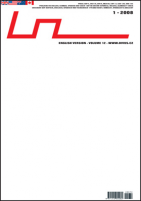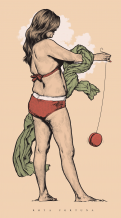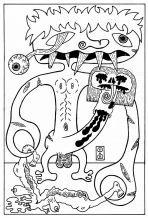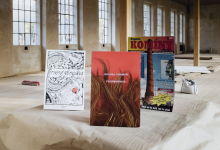| Umělec 2008/1 >> Love and death (from Mexico to Vienna) | Просмотр всех номеров | ||||||||||||
|
|||||||||||||
Love and death (from Mexico to Vienna)Umělec 2008/101.01.2008 Tony Ozuna | review | en cs de es |
|||||||||||||
|
Review of “Viva La Muerte!” — Art and Death in Latin America
Kunsthalle Vienna, October 17, 2007—February 17, 2008. The tomb of Mexico’s last Emperor, His Imperial Majesty Maximilian I, is coveted in the Royal Crypt in Vienna, Austria. It was shipped there one year after he was publicly executed by firing squad in Mexico, 1867. Before becoming Emperor, Maximilian had merely been an Archduke. Officially, he was His Imperial and Royal Highness Archduke Maximilian of Austria, Prince of Hungary and Bohemia, then at the age of 34 he was named Emperor by Napoleon III and sent to Mexico with his wife, the Empress Carlota. But that love story soon ended. If it had been left up to the Mexicans, Maximilian’s bones (drained of their blue blood) would have been left on a pile of bones with his lackeys or his French soldiers, and his skull would have been tossed on a heap. While his execution was a national triumph for President Benito Juarez, for Austrians (and Europeans in general) it was a total disgrace. And so the skulls and assorted calveras (skeletons) in the Kunsthalle Vienna’s exhibit “Viva La Muerte!” taunt, if not even seem to piss on the grave of poor Maximilian, as the show is practically across the street from the Viennese royalty’s palaces and crypt. The concept for “Viva La Muerte!” is partly inspired by the Dia De Los Muertos, or Day of the Dead, and so there are calaveras, skulls, flowers and alters to the dead in this show. It is at times joyously colorful, and thus similar to Mexico’s upbeat and cheerful, though equally macabre national holiday, celebrated privately in homes and publicly in cemeteries across the country. It presents death with a smile, a laugh and a jab in the stomach—to remind you that you’re lucky if you’re not feeling hungry today! But beyond this, the exhibit cuts deeper and more painfully into the rampant, ongoing culture of violence and death (connected to the cheapness of life) in Latin America, and particularly for those living in Mexico City (the most dangerous city in the world), Columbia, Guatemala, Brazil, etc. Curated by Gerald Matt and Thomas MieBgang, the works hit a raw nerve, revealing a great mass of land and its people dealt a bad hand. On the other hand, with exhibits like this, artists (representing generations of silence) can finally speak back, speak out, and it is clear that they don’t care anymore if there will be repercussions or not. This attitude is especially powerful in the video Quién puede borrar las huellas? (Who Can Erase the Tracks) by Regina José Galindo (born 1974). The artist walks barefoot along the sidewalks of Guatemala City, carrying a metal bowl full of blood and periodically steps into the bowl to leave footprints of blood in her path. Galindo walks with a purpose: from the Constitutional Court building to the National Palace, and each footprint symbolizes the thousands of innocent civilians who died at the hands of the army and paramilitary groups (backed financially and militarily-trained by the CIA), during the over 40-year-long “civil war,” or land struggle between Mayan Indians and Ladrino (mestizo plantation owners) from 1954-1996. Though officially ended, this struggle is ongoing. Quién puede borrar las huellas? was done to protest against the candidacy of ex-dictator Efraín Ríos Mont in the 2003 presidential elections. Though General Rios Mont was only in power from 1982 to 1983, he is recognized as one of the most ruthless military dictators in Guatemala’s history with as many as 10,000 Indians killed, and over 100,000 more fled to Mexico because of his “born-again Christian” campaign against suspected leftists. Juan Manuel Echvarría (born 1947), has selected work from his series, Corte de florero, which are pristine black-and-white photos of human bones in floral arrangements and photographed in the style of botanic prints. He is paying homage to a famous botanical expedition of Columbia in the 1780s, which marked the first classification and analysis of indigenous vegetation. The name of his series, however, also refers to a brutal practice that was common during the political conflicts of the 1950s in Columbia, between leftists (peasants) and conservatives (land owners). In those days, Corte de florero, was slang for the severing of body parts and the head of victims, and these severed limbs were then inserted into the victim’s neck, as flowers are stuck into a vase. Vik Muniz’s Clown Skull is a real human skull (in a glass case), intact with teeth, a grin, and a clown’s bulbous nose (that looks like bone), stuck onto it. For Muniz (born in Sao Paulo, i 1961), the clown skull refers to Brazil’s right-wing military-dictatorship of the 60s and 70s. It is an image of death laughing in the face of its victims—and it is a skeletal face of a clown, a joker, and thus, posing as innocence, it is the face that immersed Brazil in “terror, censorship, lies and fraud,” under the guise of reform. Another Brazilian, the esteemed Cildo Meireles (born 1948), commands the middle portion of the exhibit with his installation Como construir catedrals (How to Construct Cathedrals, 1987). In this work, black curtains surround a hallowed space, which has a ceiling of 2,000 human hip and leg bones hanging vertically; in the center of the space there is a pond of silver coins (60,000 of them), and rising from the middle of this sea of money is a thin stack of 800 communion wafers (used in Catholic masses). The money is enclosed by grey cement blocks, with a dim light overhead (above the bones) creating a calm, spiritual atmosphere. This work recalls the era in South American history when seven Jesuit missions were established, between 1610 and 1767, in Brazil, Paraguay and Argentina, to convert the Indians to Catholicism in de facto indoctrination slave camps. In this brutal attempt to convert a whole civilization to a new religion, a “fatal connection of power, wealth and spirituality” took root and retains an uneasy presence and truce in society to this day. Cristina García Rodero (born in Spain, 1949) presents a series of photos titled Occult Spain: Spanish villagers (in modern times) following century-old pagan or heathen celebrations, rituals and processions, not dissimilar from rites and processions of Spanish Catholicism with its own strange medieval rites. And thus, the unusual marriage of cultures that created Dia De Los Muertos shouldn’t be surprising to anyone, as both cultures were already rooted in death and violence, and as if they were almost bound to have merged at some point in history: the Catholics of Spain with their inquisitions and occult and pagan rituals, and the Aztecs with their own death aesthetic including gory human sacrifices to their sun god. Luckily, black humor is never forgotten—especially with the works of the Mexican artist known as Dr. Lakra (born 1972), who draws enigmatic skeletons over found studio-photos, postcards, and posters from a past era. No matter how glamorous and sexy you are, death is ever present—its shadow just around the corner, with a finger on your shoulder. Finally, underlining the loose mixture of cultures in this exhibit, the American and Cuban partnership of Jennifer Allora (born in Philadelphia, 1974), and Guillermo Calzadilla (born in Havana, 1972) who are both living in Puerto Rico, provides a video work titled Sweat Glands, Sweat Lands (2006), which is funny as hell—but with a raging bite. The video begins with close-up shots of a roasting pig, spinning around in someone’s backyard; then the viewer realizes that the spit is being turned by the crankshaft of a car, which is stationary (on blocks). A guy sits in the car, revving the gas,and coolly smoking a cigarette, listening to some Reggaeton—or rather a Reggaeton singer reciting a political rant/poem in Spanish, just a sample of which goes like this: “What is the social order? What is your special order? Hot dog juice? Democracy?” The singer reads to a sobering bed of sound, not a beat or rhythm, which gives the words a harder edge. The scene is both ridiculous and realistic in its context. And so, with all the political and socio-historical baggage attached to the works in this exhibit, a total of 24 artists have collectively created an overwhelming feeling of hopelessness coupled with a repelling, yet enticing smile and the sweet scent of death. There’s a whole lot of death in “Viva La Muerte!” which can be crippling and demoralizing, but it also conveys a sense of how many people (especially innocent victims) feel in their situations. There is an inspirational quote for this show provided by Octavio Paz: “Our cult of the dead is a cult of life, as all love thirsty for life longs for death.” This is more a lure and hook, however, than an accurate summation of the works in this group exhibition. Kunsthalle Vienna likely intended that the co-exhibit and main attraction, a group show titled “True Romance—Allegories of Love from the Renaissance to the Present,” would offer a relief from, or psychological counterpoint to “Viva La Muerte!” In fact, it is a perfect counterpunch. The large video projection at the entrance, Rest Energy by Marina Abramovic, makes the point clearly enough: a man and woman stare at each other between a large bow and arrow—the woman holds up the bow, while the arrow is pulled taut and ready to shoot right at her heart, but the man holds the arrow (at the same time holding it back, preventing it from shooting her and preparing to shoot it). Death is held at bay by only one finger holding a string. The distance from “Viva La Muerte!” to “True Romance” is a two minute trip, about 50 steps up a stairway—the distance between true romance or love and death, in Rest Energy, is a split-second.
01.01.2008
Рекомендуемые статьи
|
|||||||||||||
|
04.02.2020 10:17
Letošní 50. ročník Art Basel přilákal celkem 93 000 návštěvníků a sběratelů z 80 zemí světa. 290 prémiových galerií představilo umělecká díla od počátku 20. století až po současnost. Hlavní sektor přehlídky, tradičně v prvním patře výstavního prostoru, představil 232 předních galerií z celého světa nabízející umění nejvyšší kvality. Veletrh ukázal vzestupný trend prodeje prostřednictvím galerií jak soukromým sbírkám, tak i institucím. Kromě hlavního veletrhu stály za návštěvu i ty přidružené: Volta, Liste a Photo Basel, k tomu doprovodné programy a výstavy v místních institucích, které kvalitou daleko přesahují hranice města tj. Kunsthalle Basel, Kunstmuseum, Tinguely muzeum nebo Fondation Beyeler.
|







































 New book by I.M.Jirous in English at our online bookshop.
New book by I.M.Jirous in English at our online bookshop.
Комментарии
Статья не была прокомментированаДобавить новый комментарий